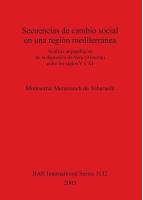Description
BOOK DESCRIPTIONThis study focuses on the archaeological record of South-Eastern Spain during the period stretching from the end of the Late Roman period up until the establishment of the new 'states' of the Taifa Kingdoms and the Caliphate of Cordoba. This work is a study of the area of the Vera Basin, and attempts to explain the socio-economic organisation and its interaction with the surrounding environment of this region, and is based therefore on the material remains from settlements during this period. The study is comprised of three parts, the first section is concerned with the period in which these sites existed, the second is concerned with the spatial positioning of these sites, with the third section being a general conclusion. The first section splits the period in question into six distinct phases encompassing the 3rd to the 11th centuries AD. The study looks at occupation in the area in question during these phases and discusses population fluctuations over these periods. The present day environment of the Vera Basin is a semi-desert landscape situated in the south-eastern region of the Iberian peninsula, with the palaeo-ecological data suggesting that there was a period of unusually high aridity from the 7th to the 10th centuries AD, with torrential interludes. The author looks at settlement patterns in the region, starting by covering Late Roman sites such as Baria, a small urban site, as well as numerous villae. Later sites such as Bayra are also discussed, and this was an important site in terms of administration and ideology, as a major mosque was built here, and was the capital of the Bayra district in the 11th century. The study states how the Vera Basin was a heavily populated area at the end of the Late Roman period, and this population was basedupon the extensive amount of dryland cereal agriculture, as well as a large amount of irrigational agriculture in alluvial areas. As the power of Rome waned there was a general period of depopulation, with the population becoming dispersed into smaller communities. A majority of the population remained centred around the lowland areas. From the 6th to the 8th centuries there seems to have been an environmental crisis of some kind, basically a period of alternating floods and droughts, and this in turn lead to the widespread abandonment of settlements. The appearance of glazed ceramics in the 9th century probably indicates an influx of new peoples, with three new settlements being founded in this first Andalusi phase. The period from the 10th to the 11th centuries represents a phase of population growth, although the settlements were still largely dispersed. The author concludes by stating that three-quarters of the sites in the Vera Basin were no longer inhabited after the 11th century. This shows that the settlement patterns during the Late Andalusi period did not lead directly into the period of the Caliphate, and it can be assumed that this is because of the major period of instability and upheaval that this region underwent during the 12th century.











